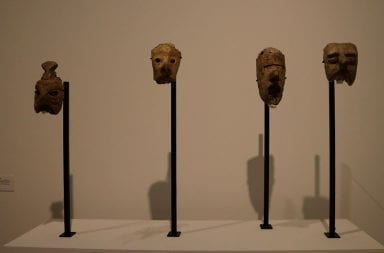It’s that time of year again, when Nerf guns and bandanas become a common sight on Ohio State’s campus as the ever popular game, Humans versus Zombies, begins its third season.
Participants gathered in Independence Hall Tuesday night for the opening ceremony, which included a presentation that went over the rules of the game and an opening act was put on by the leaders of the organization. The game officially began at 12:01 a.m. Wednesday.
Brian Finch, a fourth-year in physics and political science and vice president of Humans versus Zombies, used the game freeze tag as a comparison to explain the game.
“It’s like a modified version of freeze tag, except there are two teams where if one team tags the other player, then the other player is permanently on the other side,” Finch said.
In Humans versus Zombies, most players begin as humans and a number of players are randomly chosen to be the original zombies. Zombies must tag a human every 48 hours or they “starve to death” and are out of the game. Humans must wear their bandana tied on their arm or leg, and when a zombie tags them, they must wear their bandana around their head. Humans can defend themselves using Nerf guns and sock “grenades” to stun the zombies for a period of time. If a zombie is hit with a dart or a sock, they must retreat.
Finch said 322 students registered to play this year. Their largest game was fall 2009 with 1,200 registered, but the average is between 350 to 400 participants.
Finch was one of the founders of Humans versus Zombies at OSU and said his motivation came from a few friends who played it at Bowling Green State University.
“My sophomore year, I went to BG because their game was actually being held over Spring Break,” Finch said. “And then I played the game and I said, ‘This is awesome, I want to bring it to Ohio State.'”
However, the first thing Finch had to do was get administration to approve the game.
“They seemed fairly receptive, they were mostly actually confused about what we were trying to do because it’s something different, you don’t normally see things like this,” Finch said. “Once they realized what was happening, they were OK with it granted that we had great communication with them.”
Every game they run, Finch said he gives administration a Microsoft Excel spreadsheet with 10 to 11 tabs tallying more than 100 locations on campus where they will be playing, in addition to their rule list and any other piece of information they ask for.
The game lasts one week and runs twice a year.
As for the participants, many agreed that playing Humans versus Zombies is a nice escape from their daily routines.
“It’s a good way to just relax and not have to worry about school work,” said Nick Sabetta, a second-year in pharmaceutical science.
Julia Kramer, a second-year in mechanical engineering, said she enjoys the fantasy aspect of the game.
“I have so much fun in between classes and everything, and I did a lot of theater in high school, so it’s the acting part of it I really like,” Kramer said.
On the Humans versus Zombies’ website, there is a feedback form where participants can express their opinion on the game after it’s over.
“Beyond the typical things like, ‘This mission could have been structured better,’ or ‘You could have done various things better,’ it’s mostly positive,” Finch said. “We have a rating scale of one to five. I think we’ve never had anything below averaging four.”
As for non-participant feedback, Finch said it is mixed.
“You usually just get people laughing when we run by,” Finch said. “Students will just be like, ‘Oh, it’s that zombie game.'”
Finch said they’ve had a couple complaints about litter, but those haven’t been a major issue. There have also been a few complaints about individual players doing unsafe things, but he said they tend to work on those on a case-by-case basis.
The cost to the organization is about $500 a year, Finch said, and $200 of that comes from the Ohio Union for being a student organization on campus. The other $300 is gained through fundraisers such as Schottenstein Center cleanups. Finch said the cost to participants is a $1 registration fee and all members must find their own Nerf Guns.
For Austin Larger, a second-year in electrical engineering and Japanese, modifying his Nerf Gun is his favorite part.
“I modify the guns a lot … that means taking them open, usually removing an air valve so that more air can flow through, tightening the spring and then sealing up any holes to it,” Larger said.
Whatever the reason for participating, Finch said he encourages everyone to at least try it out.
“Just give it a shot and see if you actually enjoy it because almost everyone who has tried it out has at least enjoyed themselves,” Finch said.


